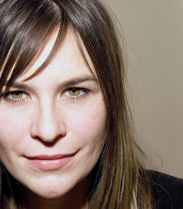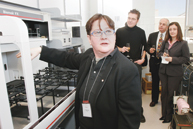PROFILE
Marci Denesiuk: Travelling great distances inside and out

Writer Denesiuk keeps few books save for Tolstoy, Dostoevsky and Lynda Barry just for a jolt.
Claudio Calligaris
As a 19-year-old Edmontonian nursing a freshly broken heart, Marci Denesiuk only saw two options — stay put and risk running into Mr. Heartbreaker on a daily basis, or hop on her trusty motorcycle, open the throttle and head for the horizon. Some three months and a 5,000 kilometer round trip to Mexico later, Denesiuk could hardly remember ol' what's-his-name as she rolled back into town.
Denesiuk's bold solo adventure is particularly striking when you compare it to the lives of the main characters in her collection of short stories, The Far Away Home, who are lonely and desperate almost to the point of paralysis and inertia. These are women who mark time in dead-end jobs, go out with the wrong men or lie in bed all day trying desperately to rouse themselves from a state of somnolence.
On November 23, the Quebec Writers' Federation (QWF) named Denesiuk's collection the co-winner of its McAuslan First Book Award, with jurors calling it "beautifully written, by understatement and indirection creating powerful moments of recognition."
Denesiuk sees distinct parallels between herself and the women who populate her fictitious universe. "I've spent a lot of time alone, sometimes by choice, sometimes not," she says. "The bike trip to Mexico is a good example; three months traveling by myself. Days could pass when I didn't talk to another person except when I filled my tank with gas."
The trip proved to be sort of a blueprint for the way Denesiuk has led her life since then — ready to roar off into a new adventure. Over the last two decades she's traveled across North America, Mexico, Guatemala, the UK and India. On the job front, she's worked as a photographer and a journalist, as well as having taught composition courses at Concordia, creative writing at Seneca College and children's literature at UQAM. And now for something completely different, she's currently working as a web designer here at McGill.
With a resumé like that, it would be easy to categorize Denesiuk as fearless. She doesn't see it like that. "It's not that I'm unafraid of change," she says, "on the contrary, I am very afraid. But unlike most of my characters, if I identify my fear as a reaction to something I want to do, then that's the exact reason I should push myself to do it."
Denesiuk speaks of her characters almost as if they are real, a common trait among authors who often equate writing a book to childbirth. If that's the case, then Denesiuk endured one of the longest pregnancies on record, having taken 10 years to write the collection and enduring another three before it was published.
After 10 years of endless writing and revising, Denesiuk knew the end was nigh when, while preparing the book as her thesis for her MA in creative writing at Concordia, she realized she had just spent two hours debating a single punctuation mark. "One comma," she laughs. "I was pulled into this comma vortex and I couldn't stop thinking about commas and what they mean and what they do. That's when I knew it was time."
Less than a year after the collection was published by NeWest Press ("It's gratifying seeing it now and knowing I can't change it"), Denesiuk is finally living the writer's life. Not only did her QWF award vault her to the forefront as one of the province's hot literary commodities, she recently earned a grant from the Conseil des arts et des lettres du Québec to go to Brussels for the first two months of the new year and work on her novel.
While Denesiuk is currently enjoying the feasting part of the artist's life, she is all too aware of the potential famine lurking outside the door. When asked what type of motorcycle she's driving today, Denesiuk ruefully admits that she is sans vehicle. "I traded my last bike for a month's rent."
Stewart's wing to foster collaboration

McGill biologist Jackie Vogel shows off a liquid-handling robot to tourgoers.
Owen Egan
On Tuesday, December 6, scientists gathered in a corridor to proudly unveil a newly renovated wing of the Stewart Biology Building, thus marking completion of the first phase of the Developmental Biology Research Initiative (DBRI). The renovations — made possible by donations from the Canada Foundation for Innovation, Quebec's Ministère du Développement économique, de l'Innovation et de l'Exportation, and the Ministère de L'Éducation, du Loisir et du Sport — represent much more than a superficial makeover for the 31-year-old facility.
"When this building first opened, scientists worked differently than they do today," Paul Lasko, DBRI leader and chair of McGill's Department of Biology, told a crowd gathered on the newly renovated fourth floor. "They worked in solitude in little boxes, not in teams or with colleagues, and the design of the building reflected that.
"Today, McGill has a large, integrated group of scientists unequalled in Canada. It's time to get our people out of those little boxes."
"This is greater than just a vision of infrastructure," agreed Martin Grant, dean of the Faculty of Science, noting that the DBRI is "feeding the pipeline" of hypothesis-driven, interdisciplinary research, "which is essential to understanding how cells work, how life works, how disease works."
The $10-million, 1,100 square-metres of state-of-the-art facilities include: new and renovated lab space and associated core facilities; high throughput robotics (for genetics, genomics, proteomics and drug-target discovery); state-of-the-art data management technology; and the world's most extensive microscopy equipment (allowing for live analysis and rapid, automated imaging of tiny cellular activity). More renovated Stewart space is set to open in January.
The Stewart renovations are just the beginning of McGill's new Life Science Complex, which the DBRI braintrust hopes will fuel interdisciplinary research by integrating the existing McIntyre Medical Building with the planned Francesco Bellini Life Sciences Building and Pavilion for Cancer Research. The Bellini Building groundbreaking is scheduled for Friday, December 9.
"Every speech needs a bad pun," warned Grant, seizing the advantage of the specialized crowd's intimate relationship with that research lab fixture, the lowly fruit fly. "Life Science is on the brink of new discoveries, and the DBRI is helping build the fly trap that will attract, and nurture, the top researchers who will transform the world in the twenty-first century."

